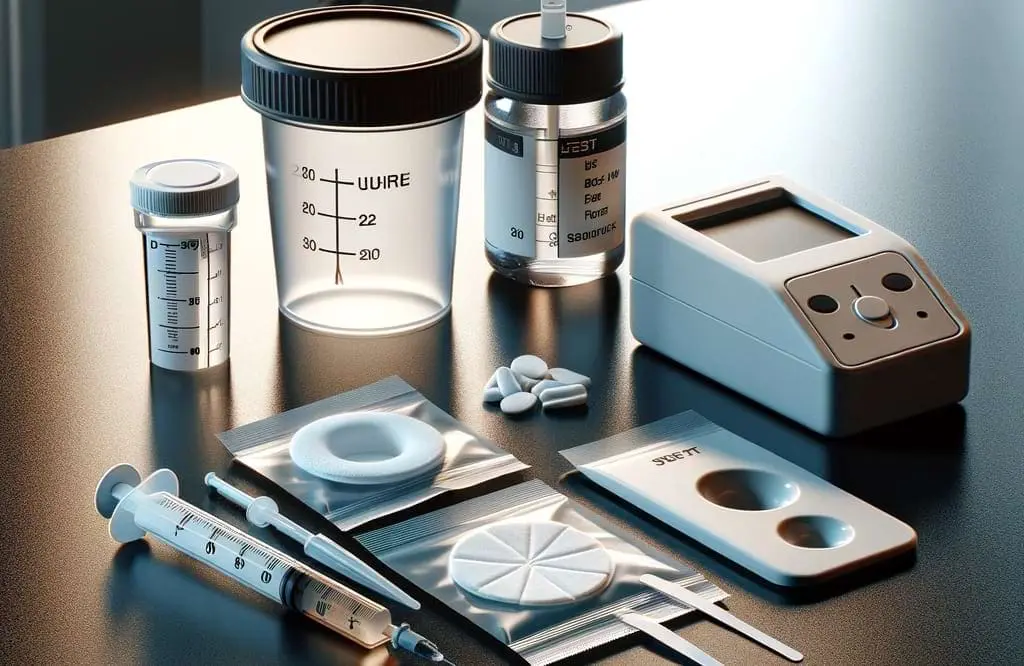A comprehensive drug test is a screening method designed to detect a variety of substances, including prescription and over-the-counter medications and illegal drugs. A comprehensive drug test can identify hundreds of substances, including those that go undetected during routine testing. These tests play a crucial role in employment screening and are useful for identifying and treating addiction.
In this blog, we look at what comprehensive drug testing entails, the science behind it, how to interpret test results, and more.
Table of Contents
Understanding Comprehensive Drug Testing

A comprehensive drug test is designed to look for hundreds of prescription and non-prescription medications, as well as illicit drugs and even alcohol. These highly sensitive and specific tests can easily identify substances in blood and urine that other tests fail to detect, making them a powerful tool for workplace and overall health screening.
Why is it Called “Comprehensive”?
Comprehensive drug panels detect many more substances than other targeted drug tests, which may only discover a certain subset of drugs or medications. Thus, these tests are considered “comprehensive” because they screen for a wide range of substances.
Common Drugs Detected
Some of the drugs that comprehensive drug screens detect include:
- Opiates, amphetamines, and narcotics—all of which can be highly addictive when used regularly and in large quantities.
- Barbiturates and benzodiazepines, including medications used to treat anxiety, insomnia, etc.
- Cannabinoids—active ingredients in marijuana.
- Antidepressants, which can cause significant side effects, including nausea, dizziness, and fatigue.
- Stimulants, which are often prescribed for ADHD and other disorders but can lead to increased heart rate, high blood pressure, and other serious side effects.
There are many reasons employers may wish to consider implementing comprehensive drug testing for their workforces. Comprehensive drug tests can reveal whether an employee or prospective employee is using substances that could impact their ability to do their jobs effectively, resulting in greater worker productivity. They can also be an effective tool for maintaining a safe and happier working environment for everyone.
Comprehensive drug screening can also help organizations reduce liability and save money. The National Council on Alcohol and Drug Dependence estimates that substance use disorders cost companies $81 billion annually through lost productivity and absenteeism, turnover and recruitment costs, workplace accidents, healthcare expenses, and more. Testing can identify employees who might be engaging in substance abuse and mitigate these costs.
Most importantly, comprehensive drug tests can lead to employees getting the treatment they need to help them become healthier. Thus, comprehensive drug testing does not just improve a company’s bottom line; it can improve employees’ lives.
Types of Comprehensive Drug Tests

There are several types of comprehensive drug tests, each with its own unique processes, benefits, and limitations. Here, we’ll explore the advantages and disadvantages of comprehensive urine and blood tests, as well as a few other lesser-known testing methods.
Urine Drug Screen
A urine drug screen is the most commonly used comprehensive drug test method. They are painless, easy, and cost-effective.
With a urine test, a person simply urinates into a plastic container and provides the sample to a technician or doctor. The person collecting the sample then measures the temperature of the sample to ensure it is suitable for testing. If it is, the sample is sealed in a plastic bag and sent to a laboratory for a urinalysis. Results are usually available within a few days or, in some cases, on the same day.
A physician or medical review officer will evaluate the test results and explain their findings to the test subject. In the case of a positive test, the subject may be asked to re-test to ensure that the results are accurate.
Blood Tests and Other Methods
Urine tests are not the only type of comprehensive drug screen. Other methods include:
- Blood tests. These very precise tests are particularly useful in detecting high levels of alcohol.
- Hair follicle tests can detect the use of cocaine, amphetamines, opioids, methamphetamines, phencyclidine (PCP), and other drugs. Hair follicle tests can vary based on the characteristics of each person’s hair. Scalp follicles have a detection time of about three months, while body hair can have a detection time of up to a year.
- Sweat tests use perspiration to determine levels of illegal substances in a person. With sweat testing, an absorbent pad is placed on a person’s skin. It is used to monitor how much of and what kind of substance the person consumes while wearing the pad. Detection windows range from hours to weeks.
- Oral fluid tests, which test for controlled substances in a donor’s saliva. Oral fluid tests were recently approved by the U.S. Department of Transportation.
The Science Behind Drug Testing
Urine drug screens are usually very accurate, but false positives are possible. In general, immunoassay (IA) urine tests are more prone to false positive results than gas chromatography-mass spectrometry (GC-MS) tests. In fact, GC-MS tests are often used to confirm the results of IA tests. GC-MS tests can also detect more substances, making them the most comprehensive of all urine drug screens.
GC-MS combines gas chromatography and mass spectrometry to identify various substances in a test sample. Gas chromatography separates and analyzes compounds in a mixture; mass spectrometry measures the mass-to-charge ratio of ions. When put together, the two analytical processes can positively identify even very small amounts of substances in a person’s system. This makes the GC-MS test the “gold standard” when it comes to comprehensive drug testing.
However, GC-MS testing is more expensive than an IA test, and the results take longer to retrieve. Therefore, IA tests are more commonly used.
An IA test measures the presence of macromolecules through the use of an antibody or antigen. These antibodies can detect the presence of drugs and other substances. IA testing is usually considered the frontline when it comes to comprehensive drug testing because of its ease, cost-effectiveness, and ability to deliver results quickly.
Interpreting Drug Test Results
Interpreting the results of a comprehensive drug test can sometimes be challenging. According to the Mayo Clinic, people who misuse drugs are adept at finding ways to mask their drug use, via methods such as adulteration, urine substitution, and urine dilution. It’s important that physicians and medical review officers know what to look for, including:
- The color of a urine sample. A normal urine sample is pale yellow or clear, depending on concentration.
- A pH less than 3 or greater than 11, which could indicate adulteration or dilution of the sample.
Assuming the sample has not been tampered with, the actual interpretation of test results is straightforward. That’s because drug screen results are reported as either positive or negative. Some tests will state the concentration of the drug or metabolite contained in the sample.
Factors Affecting Test Results
There are many factors that can affect the results of a comprehensive drug screen. Some of the most prominent ones include:
- Metabolism. High metabolism helps a person’s body process and remove the residue of drugs more quickly. Therefore, a test performed on a person with a high metabolism has a higher chance of returning a false-negative result.
- Drug half-life. Half-life is the amount of time a drug stays in a person’s system. Half-life is different depending on the drug. Some drugs have a longer half-life than others, which makes them more likely to show up in a drug test (depending on when the test is taken). For example, the half-life of Xanax is four days, whereas the half-life of Fentanyl is one to three days.
- Frequency of drug use. A substance that is used more frequently is more likely to be discovered on a comprehensive drug test, simply because there is a higher likelihood that the drug may be in the subject’s system at the time of testing.
- Dosage. The higher a drug’s dosage, the more likely it will be detected during a drug test.
Frequently Asked Questions About “What is a Comprehensive Drug Test”

What does a comprehensive drug test include?
A comprehensive drug test is a test designed to detect hundreds of possible medications and illicit drugs in a person’s system. Comprehensive drug tests look for both prescription and non-prescription medications, illegal substances, and, in some cases, alcohol. They are generally performed through urinalysis, but blood tests, hair follicle tests, and others can also be performed.
What is the most accurate type of drug test?
The most comprehensive urine drug test is a gas chromatography-mass spectrometry (GC-MS) test, which positively identifies even very small amounts of substances in a person’s system. This makes the GC-MS test the “gold standard” when it comes to comprehensive drug testing.
What is a 12-panel comprehensive drug test?
A 12-panel comprehensive drug test is a urine drug test that tests for 12 different metabolites in a person’s system. It can accurately detect substances—including painkillers, opiates, and stimulants—that may be more difficult to detect on smaller panel drug tests.
Conclusion: The Importance of Comprehensive Drug Testing
Comprehensive drug testing is a critical tool for ensuring a safe and productive workplace. With comprehensive drug testing, employers can proactively tell if employees and prospective employees are using substances that could impact their job performances—and their overall well-being. Proactive drug testing can also help organizations avoid the costs and liability associated with drug use in the workplace, which costs companies billions of dollars every year.
Acuity’s comprehensive drug testing services are available 24/7, wherever and whenever they are needed. Featuring Medical Review Officers and Medical Review Officer Assistants with decades of experience, Acuity’s drug testing services are ideal for all industries, whether they require regulated or unregulated testing.
Learn more about how Acuity can help you meet your drug testing needs.
